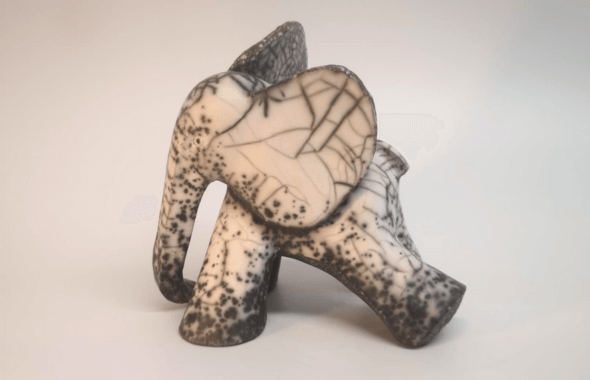

Raku Sculptures
No matches for the requested criteria.
More than 30 000 artworks in all styles
Buying Raku Art Sculptures from Carré d'artistes
Are you thinking about adding a raku sculpture to your collection?
Raku ceramics captivate art enthusiasts with their mystical aura and unique aesthetic. These raku pieces are gaining immense popularity in contemporary art, blending tradition with innovation to create treasures that are both timeless and modern.
Read more
What is raku?
Raku is a centuries-old firing technique rooted in Japanese culture. Originally associated with tea ceremonies in Japan and Korea, traditional raku has evolved over time while maintaining its connection to Zen philosophy.
This process, which imparts distinctive textures and finishes to ceramics, was historically used to craft vessels for enjoying tea. Today, styles of raku range from small pottery pieces to intricate raku sculptures, including abstract forms, figurative works, and striking vases.

Process of creating raku pottery
Creating raku ceramics involves several intricate steps that require precision and patience.
- Shaping: The artist uses a potter’s wheel to form the piece, often incorporating materials like sand, grog, or crushed clay for added durability.
- Drying: The clay is air-dried for days or weeks, depending on the size and weight of the object.
- Bisque Firing: The first firing, or biscuit firing, occurs at temperatures between 800°C and 850°C to remove all moisture and harden the clay. This step must be done slowly to prevent thermal shock.
- Glazing: The piece is coated with raku glaze using techniques like dipping or brushwork. The glaze can include classical materials such as kaolin, silica, borax, and colored oxides.
- Raku Firing: The most distinctive step, raku firing, involves heating the piece between 800°C and 900°C. The clay is removed from the kiln at high heat and placed in a container with combustible materials like straw or sawdust. The burning materials create a reduction atmosphere, altering the glaze and clay’s appearance.
- Cooling and Cleaning: After the firing, the piece is cooled and meticulously cleaned to remove carbon deposits and reveal the final surface.
Western-style raku, developed in the 1960s, emphasizes the dramatic thermal shock during firing, resulting in the recognizable cracking patterns and unpredictable color variations that define raku pottery.
Contemporary Raku Sculptures: a dialogue between heritage and innovation
Contemporary raku sculptures combine ancestral techniques with modern creativity, pushing the boundaries of this ancient art form. Artists skillfully balance fire, chance, and expertise to craft works that evoke emotion and captivate the viewer.
This style of pottery is more than just a firing technique—it’s a visual dialogue between past and present. Each raku sculpture reflects the ceramist’s mastery and innovation, often featuring themes like feminine beauty or abstract expression.
So, is raku pottery valuable? Absolutely. The meticulous processes and the unique interplay of fire and materials make each piece a one-of-a-kind treasure.
At Carré d’artistes, we showcase a wide selection of raku pieces, offering both timeless tradition and modern artistry. Whether you’re looking for a centerpiece or a decorative accent, our collection of raku ceramics and sculptures highlights the beauty and versatility of this remarkable art form.
SCULPTURES BY TECHNIQUE
Sculptures By STYLE


2.jpg)




